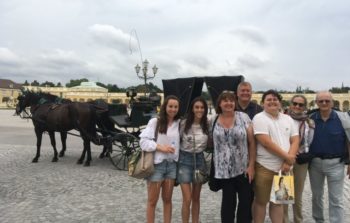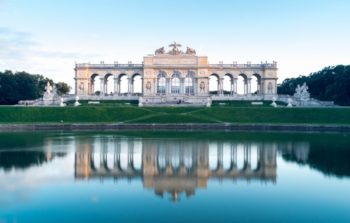Overview of Your Tour

Schönbrunn Palace Gardens and The Gloriette
We begin our tour of this astonishing palace with a stroll through the magnificent formal gardens, exploring the Baroque landscaping principle of interlaced nature and architecture illustrated throughout the grounds. Schönbrunn Palace was built to rival Versailles, though many say it surpasses the famous French palace in grandeur.
From the Grande Parterre, we gaze at the Gloriette in the distance, a huge triumphal arch situated on a hilltop with panoramic views of Vienna’s woods, which recalls the military victories that made Empress Maria Theresa’s reign (1740-1780) a highpoint of the Habsburg dynasty’s political and cultural dominance in Europe.
Strolling by the the Neptune Fountain, the Roman ruin, Privy garden and Orangery, we consider how this wondrous park was opened to the general public in 1779, a populist gesture that reveals Maria Theresa’s canny charm offensive towards her subjects. Indeed, it was under Maria Theresa’s direction that Schönbrunn Palace became the focal point of Austria’s imperial policy and the center of court life.

Schönbrunn Palace and Maria Theresa’s Music Room
Schönbrunn Palace functioned as the summer residence of a reigning family counting no fewer than 16 children! Many of this teeming brood of young royals did not survive to adulthood, but the palace sympathetically preserves the memories of their infancy, childhood summer activities, hobbies, illnesses, and early loss. Throughout our tour, your expert historian guide shares insight into daily life for the generations who called the palace home.
For example, the imperial family would regularly gather in Maria Theresa’s music room for performances and rehearsals, and a six-year-old Mozart even played for them here. The Habsburgs’ devotion to the development of classical music did not end at their support of brilliant composers; many of the children were trained as advanced musicians themselves and were expected to exhibit their skills in private entertainments held in this space. During our time here, we take a moment to admire the music room’s glittering Rococo mirrors and lavish chandeliers – regarded as late-Baroque.

The Franz-Joseph and Elisabeth Apartments
The next generation of Habsburg rulers also put their stamp on Schönbrunn, a point your knowledgeable guide will illustrate in the Franz-Joseph and Elisabeth Apartments.
In 1854, Emperor Franz Joseph married the Bavarian princess Elisabeth (known by the affectionate nickname Sisi), who despised the rituals of court life and the ornate surroundings of the summer palace. She even went as far as to commission a spiral staircase leading from her official rooms to a private passage, from which she could flee the palace to the gardens beyond. As we explore the opulent apartments, your guide shares valuable insight into the story of a couple torn apart by the burdens of the State.
The Hall of Ceremonies, Porcelain Room, and Millions Room
Visiting one lavish space after another, we gain a sense of the relentless opulence which Sisi found so unbearably stifling – such as the spectacular dining room, with its precious tableware and “imperial napkins” in the form of the fleur-de-lys.
We’ll stroll through the Hall of Ceremonies – where lavish celebrations such as the wedding of Crown Prince Joseph were held – and the so-called Porcelain Room (Maria Theresa’s private office), with its décor actually designed by the imperial children themselves in an elegant chinoiserie style.
In the unique Millions Room – which earned its name through its eye-watering price tag – we admire antiquated Indo-Persian miniatures with rococo-frames, and wall hangings manufactured in carved rosewood from the Antilles. Such impressive features work together to make the Millions Room one of the most accomplished combinations of Rococo-era Oriental and European decorative art in the world.